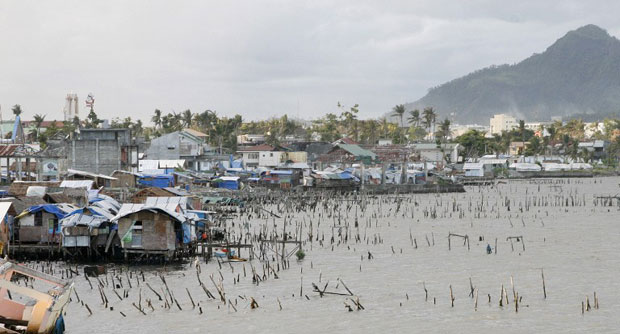
The coastline of Tacloban City on May 7, 2014, still bears scars from the massive damage left by Super Typhoon Yolanda that devastated the central Philippine city six months ago. The storm, the strongest ever to hit land, left more than 7,000 dead or missing and ravaged whole cities when it struck on Nov. 8, 2013. Aid officials say that the affected areas have made a remarkable recovery but years of hard work still lie ahead before the area is restored to normal. AFP
TACLOBAN CITY, Philippines—Parts of the Philippines laid waste by Super Typhoon Yolanda (international name: Haiyan) are showing signs of recovery six months later but years of work lie ahead, aid officials said Wednesday.
In the central city of Tacloban, which bore the brunt of the most powerful typhoon ever to hit land, streets are free of debris and the stench of rotting flesh has disappeared.
But thousands still live in evacuation centers, worried about their future.
“The challenges are indeed great. They are also surmountable,” UN resident and humanitarian coordinator for the Philippines Klaus Beck told a news conference in Tacloban.
“Rebuilding livelihoods is an enormous challenge.”
Farmer Marcelo Silvano, 66, who saw half his coconut farm wiped out in the nearby town of Tolosa, said extra jobs are needed.
“There are so many of us who cannot find work. All I can do is plant root crops and vegetables for home consumption. I am even short of farm tools,” he told AFP.
The storm, which struck last Nov. 8, left 6,293 dead, 1,061 missing and about 4.1 million people displaced, Red Cross figures showed.
It caused massive damage to homes, businesses, schools and roads, with power, water and all essential services in an area the size of Portugal cut off.
Int’l humanitarian effort
An international humanitarian effort has helped millions get back on their feet.
Water and electrical services have been restored in many areas and businesses are reopening. After a brief surge in looting just after the storm, police have returned to the streets.
“I can say without mental reservation that we are right on track,” the head of the government reconstruction efforts, Panfilo Lacson, declared Wednesday in Manila.
Lacson and UN officials both noted that despite the widespread destruction, caused mainly by tsunami-like giant waves, there had been no epidemics, no famine and no long-term collapse of law and order.
The UN Food and Agriculture Organization said in a report that 600,000 hectares (1.48 million acres) of farmland and 33 million coconut trees—vital to local livelihoods in one of the country’s poorest areas—had been destroyed.
Seeds, fertilizer, farm tools and alternative livelihood help had allowed about 80,000 families to bring in their first harvests since the typhoon, it added.
Huddled under shelters
The effort has shifted toward long-term recovery but the challenges are still serious.
Ned Olney of Save the Children said only half of hospitals and clinics in affected areas are back in operation and many are functioning under tents without vital medical equipment.
Many of the displaced are still huddling under makeshift shelters, which means they would be even more vulnerable when the typhoon season begins next month, he warned.
“If we have another medium-sized typhoon hitting these areas, we’ll essentially be knocked back to where we were six months ago,” Olney told reporters.
UNDP administrator Helen Clark said in a report that full recovery could take a decade or more, and need more than just rebuilding physical structures.
World Health Organization country representative Julie Hall said other health concerns were now coming to the fore.
“Six months after the event, we are seeing the emergence of mental health problems in communities with people coming to terms with the enormity of their loss, whether of loved ones, homes or livelihoods,” she said.
Safe and clean facilities were needed for the 70,000 births expected in the next three months, as well as for people with existing diseases like diabetes, cancer and tuberculosis, she said.
“Building back better” has become the slogan of the government—an attempt to make devastated areas less vulnerable to new disasters.
But this means the government must build almost 217,000 new homes for people resettled from coastal areas and riverbanks where they were vulnerable to typhoons and flash floods, Lacson said.
Finding safer sites has proved difficult as much available land is isolated and rugged.
Some people like fishermen oppose moves taking them far from their jobs. But Lacson said they could not remain, warning “where will we find our countrymen if there is another storm?”
Even the damaged environment needs time to recover.
Fisherman Losanto Castillo, 55, said he was grateful to the government for giving him a new fishing boat.
“But how can I have a good catch when the waters are polluted and still filled with garbage from all the objects that got washed out to sea?” he asked.—Imelda Magbutay
RELATED STORIES
UN: We need fresh funding for critical programs
Unicef sees promising signs on the long road to recovery